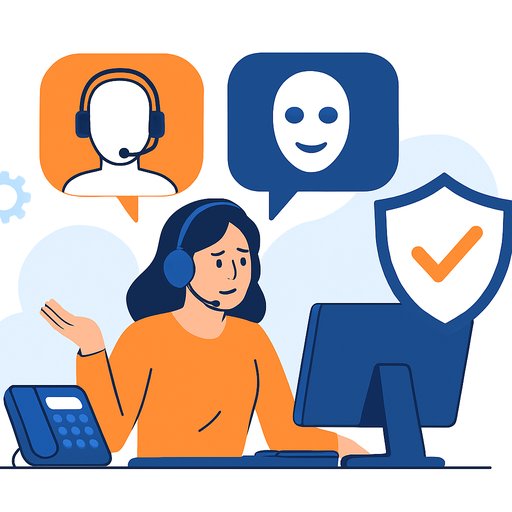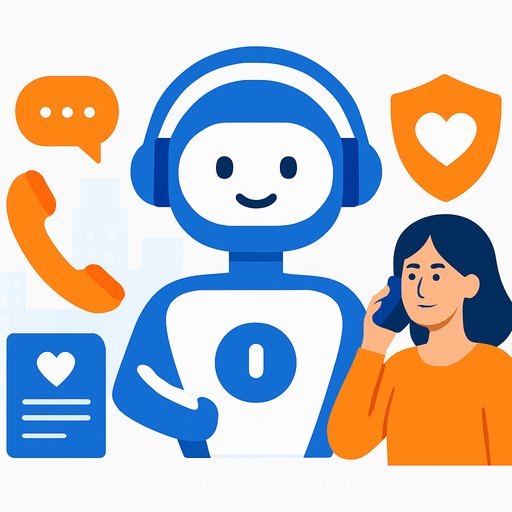Inbound Voice Is the New CX Threat Vector: Why Contact Centers Can't Ignore Voice AI Fraud
Fraud has moved to your phones. AI-generated voices, imposter calls, and IVR mining are slipping past old defenses and leaning on human error.
Digital channels got stronger. The voice channel didn't. Now it's being exploited at scale, and support teams are feeling the impact first.
Why the Phone Channel Is Exposed
- Most inbound verification still leans on knowledge-based questions. Those answers are easy to buy, phish, or guess.
- AI voice synthesis lets attackers sound convincing, even familiar. Basic screening won't catch it.
- IVR mining gives attackers a playbook. They probe 1-800 flows, learn your quirks, then strike.
- Attacks are multimodal. Voice plus SMS or email to find the weak entry point.
- Targets are shifting downmarket. Regional banks and healthcare organizations are being hit harder with fewer tools and less mature stacks.
Zero Trust for Voice: Never Trust, Always Verify
Treat every call- inbound and outbound- as unverified until proven otherwise. That's the same mindset your security team uses for data and apps.
Zero trust for voice pairs AI with network-level checks to confirm a call really comes from the device and network it claims. Think of it as multi-factor for phone conversations.
What that looks like in practice: carrier-level validation, call-origin interrogation, risk scoring before an agent ever says "hello," and synthetic voice detection running in near real time.
If you want a grounding on zero trust principles, see the NIST Zero Trust Architecture.
Filter Fraud at the Edge
The best place to stop fraud is before it reaches your team. Use network intelligence to flag repeat offenders, cross-bank probing, and device-to-number mismatches.
Run synthetic voice detection within the first 15-30 seconds. That window lets you spot fake callers before any sensitive info leaves your systems.
The goal: shield agents from pressure, keep handle times realistic, and let legitimate customers through without delay.
What Support Leaders Should Do This Quarter
- Map trust boundaries: Define what agents can share pre-verify vs. post-verify. Lock down PII and transaction changes until verification is complete.
- Add edge screening: Score calls using carrier signals, device checks, and velocity rules (e.g., same number hitting multiple institutions).
- Step-up verification: For high-risk intents (password reset, wire changes), use secure callbacks to verified numbers or in-app push confirmations.
- Kill static KBA: Rotate to dynamic challenges, one-time verifications, and out-of-band confirmations tied to known devices.
- Train for tells: Odd cadence, refusal to switch channels, rush to reset access, scripted responses. Teach agents to pause and escalate.
- Instrument the flow: Track verification time, false positive rate, fraud loss per call type, and abandonment before/after screening.
- Unify voice + messaging signals: Share risk scores across channels to stop ping-pong attacks.
Agent Playbook: Scripts That Reduce Risk
- "Thanks for calling. Before we discuss account details, I'll complete a quick security check."
- "For this request, I'll send a one-time confirmation to your verified device. Let me know when you receive it."
- "I can finish this via a secure callback to the number on file. Is now a good time, or should I schedule it?"
- "I'm not able to proceed without verification. I can move us to a secure channel or connect you with a specialist."
Selecting Vendors: Questions That Matter
- Do you verify call origin at the carrier/device level, not just caller ID?
- Can you score and block/redirect calls before an agent picks up?
- How fast is your synthetic voice detection, and what's the confidence threshold?
- How do you handle data privacy, storage, and redaction for call audio and metadata?
- Can you feed risk outcomes to our CRM/agent desktop in real time?
- What's the pricing model, and how do we quantify ROI across fraud loss, AHT, and CSAT?
KPIs to Prove the Business Case
- Verified calls as a percentage of total inbound
- Fraud loss per 1,000 calls and per intent type
- Time-to-verify vs. first-contact resolution
- False positive rate and deflection accuracy
- Agent escalations due to risk flags
- CSAT/NPS for verified vs. non-verified journeys
Turn Security Into CX
Strong security is not friction. It's a promise. Customers will wait a few extra seconds if they trust you more and lose less.
Be explicit in your messaging: "We verify every call to protect your account." It sets expectations, builds confidence, and gives your team cover to do the right thing.
If you want to upskill your team on safe AI use in support workflows, explore practical training by role at Complete AI Training.
The Bottom Line
Treat the phone like any other access point: zero trust, AI-augmented, and continuously verified. Filter at the edge, give agents better tools, and keep learning-because attackers are.
If you need a quick primer on synthetic voice risks to share with stakeholders, the FTC has a clear overview of voice cloning scams: read it here.
Your membership also unlocks:






